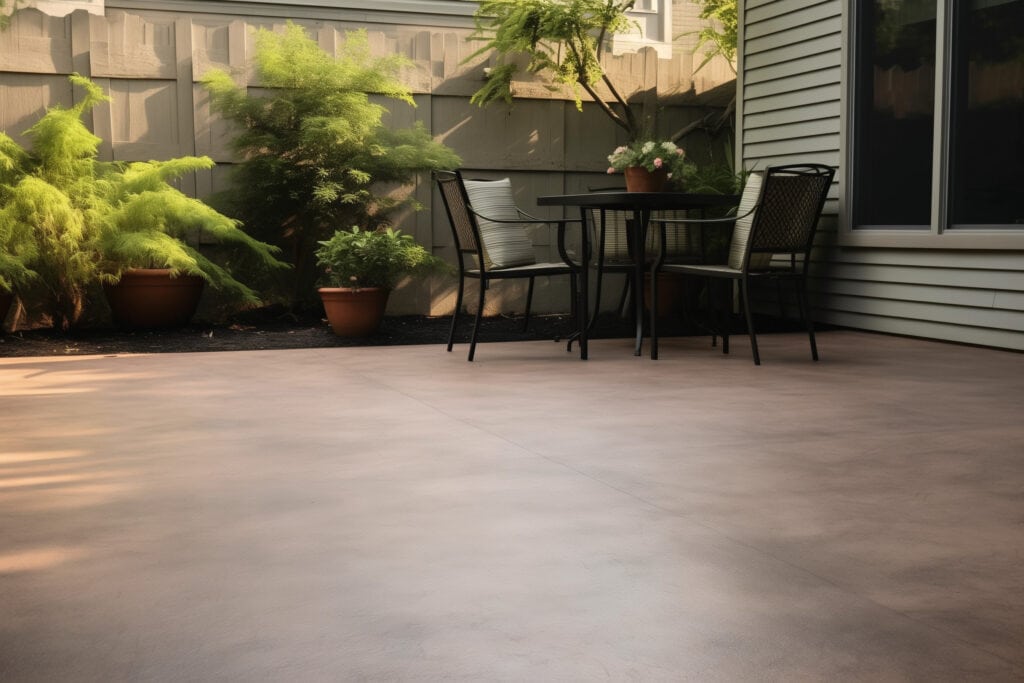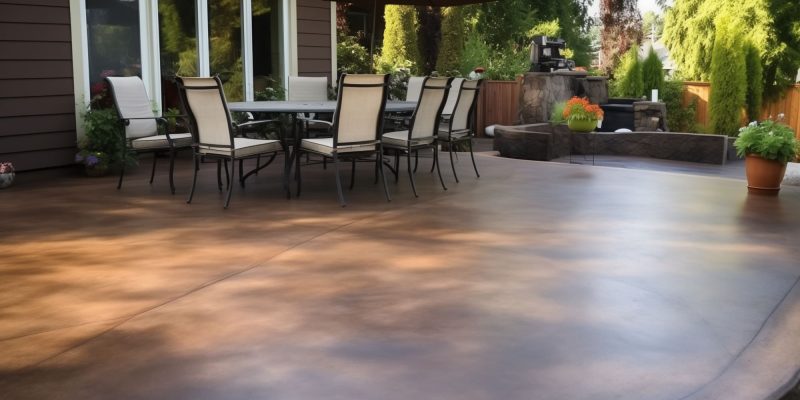When planning a new decorative concrete patio, the color selection process can seem daunting. But have no fear! Choosing alluring, creative colors for your outdoor living space is an art form that brings environments to life when done thoughtfully.
The Psychology and Science Behind Color Selection
Different hues, saturations, and shades unconsciously elicit emotional reactions. Warm earth tones promote comfort and familiarity. Cool grays exude modern sophistication. Punchy bright colors grab attention.
Additionally, colors appear differently based on lighting conditions and time of day. Shadows mute tones in the evening. Northern light intensifies color saturation compared to southern exposures.
Further examine how sunlight moves across the potential patio position during different seasons. In summer when the sun sits higher, opaque shade structures or plants spare residents from stark light washing concrete out. Map sunlight patterns to determine peak color showcase times.
Pay attention to exterior lighting possibilities too. Ambient string lights, smart color-tunable bulbs, or strategically placed landscape luminosity transforms plain concrete into dynamic canvases.
Drawing Inspiration From Design Elements
Begin by walking your property with fresh eyes. Notice how the main house colors make you feel and any accents like plants or garden beds. Rustic brick cladding suggests a matching red-hued patio while Mediterranean white stucco homes need subtle neutrals like sand or cream.
Moving inside, also examine interiors to extend preferred color schemes outside. Reference beloved paint swatches right on the patio site, mimicking beloved indoor hues. Photos of backyard patio designs attracting your eye posted on design sites like Pinterest fuel ideas too.
Gather actual material samples to accurately envision colors against existing elements. Line up concrete chunks next to exterior stone veneers or brick walls onsite. View stucco colors beside potential stained slabs representing the truest rendering short of full installation.
Talk through impressions of how sample hues make you feel when positioned in the actual intended patio location. Do the tones energize the area or impart calmness? Determine which palettes align with the mood you aim to achieve for the space.
Selecting the Perfect Color Family Group

Soothing, Flexible Earth Tones
Ranging from creamy neutrals to deeper mochas, earth tones beautifully blend with greenery and hardscapes like stone or wood. Whether aiming for a modern, farmhouse or romantic Tuscan aesthetic, earth-hued patios provide pleasing contrasts against darker vertical landscapes and bright flowers.
Light tan concrete resembling weathered limestone or sandstone works well against red brick buildings. Rich chocolate browns complement prairie-style architecture through shared nature-inspired roots. For colonial white homes, subtle bone or oatmeal tones prevent overpowering contrast.
Crisp, Refined Grays
For a lighter clean palette with modern lines, various cool-toned grays hit the mark. Go for true grays to prevent any muddy shifts into green or brown hues. Instead play with lighter soft tones versus darker sophisticated charcoals. Matte finishes keep the look subtly refined while glossy sealants amp up bold contrasts.
Vibrant, Eye-Catching Brights
Pops of citrus yellows, grassy greens. Balance is key when using bright patio colors. Consider vivid mosaic inlays or bold borders against neutral foundations.
Skillfully Pulling Color Schemes Together
Much like interior designers unite furniture, accent pieces, and artwork, strategically curate cohesive exterior color stories. Contrast lightly tinted concrete with darker borders and aggregate accents. Or opt for harmonious tones in the same family, like pairing warm caramel and chocolate brown hues.
Also borrow color blocking techniques to make dining spaces pop. Keep seating zones neutral while saturating surrounding patio surfaces in intense complementary colors.
In terms of laying out scheme flow, begin by painting the largest structural surfaces like walls or fencing with colors forming the main “foundation”. Next transition to hardscaping elements like paved surfaces digitally rendered in potential colors. Finally accessorize with movable décor pieces easily swapped if tastes evolve.
Another pro tip? Opt for integral concrete coloring mixed directly into concrete truck batches for unmatched uniformity and longevity versus surface stains or dyes. The color consistency stays true as the slab cures with the pigment present throughout.
Thinking Long-Term About Design
Unlike short-lived paints and stains. Even better, concrete patios only get more beautiful with age taking on artisan-like character from weather-worn variegation and cracks. Natural patina lends authenticity, creating the appearance of installer-applied acid washes seen in boutique hotels.
Still aim make color choices flexible to changing style preferences over time. Additionally, changing sunlight patterns through landscaping growth impacts color perception. Those baby trees eventually grow to cast more shadows. The positioning of design elements like pergolas and privacy walls alter light as well.
Keep the big picture in mind during color selection by also looking years down the road. How might patio usage evolve if starting a family or opting to age in place? Contrasting colors between distinct functional zones aids visibility for aging eyesight while keeping newly mobile toddlers safely corralled.
And for resale value aesthetics, timeless color combos using classic neutrals, versatile earth tones, and velvety charcoals attract the widest buyer demographics. Pops of color via paint, cushions and garden blooms customize spaces for individual interests instead of niche color preferences.
Concluding Thoughts on Mixing and Matching
Choosing patio color combinations is indeed an artistic process informed by environmental factors, textural contrasts, emotional connections and long-term intentions.
Schedule an on-site color consultation with designers early when opting for specialty decorative techniques like etching, staining, engraving, exposed aggregates, or other treatments. Experienced industry experts illuminate considerations like porosity, sealing, maintenance and Freeze-Thaw exposure based on Iowa conditions and individual properties.
They also facilitate navigating the numerous concrete coloring, patterning and texturing possibilities in harmony. What acid-staining hues contrast well with antiquing releases? How do secondary accents like glass beads or colored stone hold up in winter? It takes an artistic eye to curate the right overall scene.
Soon that blank concrete canvas transforms into a lively backyard showcase for entertaining and everyday relaxing against an on-trend backdrop. And the best part? Durable integrally colored concrete patios only increase in visual interest over time, meaning that with a thoughtful color palette in place, the artisanal beauty lasts for decades to come.
Frequently Asked Questions
Is colored concrete a good idea?
Yes, colored concrete is an excellent idea for patios, driveways, pool decks, etc. It is more aesthetically pleasing, can mimic pricier materials like stone or wood, is very durable for the Iowa climate, and adds value to homes. Integral coloring mixed throughout lasts longer than stains.
What is the best color for a concrete patio?
Earth tones like tans, browns and warm grays that blend with landscaping are ideal concrete patio colors. Light reflectivity should be considered too – lighter colors won’t retain heat as much. Cool tones work well in hot climates. Accent colors liven things up.
Can a cement patio be colored?
Absolutely! For existing concrete slabs, specialized decorative coloring products like acid stains, dyes, overlays or engraving create pops of color. But for best uniformity and durability, integrally colored concrete mixed from the start has better color consistency and longevity.
Is colored concrete more expensive?
Yes, integrally colored concrete runs 10-15% higher in cost than plain uncolored concrete due to the pigments used in the mix design. But the aesthetic benefits and ability to mimic premium building materials for less pays off. And decorative techniques like stamping, etching and stenciling provide even more dramatic, high-end visuals over time versus dull gray.

